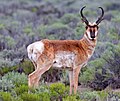Baja California
Baja California | |
|---|---|
| Free and Sovereign State of Baja California Estado Libre y Soberano de Baja California(Spanish) | |
| Anthem: "Canto a Baja California" | |
 State of Baja California within Mexico | |
| Coordinates:30°00′N115°10′W/ 30.000°N 115.167°W | |
| Country | Mexico |
| Capital | Mexicali |
| Largest city | Tijuana |
| Largest metro | Greater Tijuana |
| Before statehood | North Territory of Baja California |
| Admission | 16 January 1952[2](29th) |
| Government | |
| •Governor | |
| •Legislature | Congress of Baja California |
| •Senators | |
| •Deputies | |
| Area | |
| • Total | 71,450 km2(27,590 sq mi) |
| • Rank | 12th |
| Population (2020)[4] | |
| • Total | 3,769,020[1] |
| • Rank | 14th |
| • Rank | 19th |
| Demonym | Bajacaliforniano(a) |
| GDP | |
| • Total | MXN 1.082 trillion (US$53.9 billion) (2022) |
| • Per capita | (US$14,185) (2022) |
| Time zone | UTC-8(PST) |
| • Summer (DST) | UTC-7(PDT[a]) |
| Postal code | 21, 22 |
| Area code | |
| ISO 3166 code | MX-BCN |
| HDI | |
| Website | Official website |
| ^a. 2010 and later. Baja California is the only state to use the U.S. DST schedule state-wide, while the rest of Mexico (except for small portions of other northern states) observes standard time year-round.[6] ^b. The state's GDP was 294.8billionpesosin 2008,[7]an amount corresponding to 23.03billionUnited States dollars,with US$1 valued at 12.80 pesos (value of 3 June 2010).[8] | |
Baja California[note 1](Spanish pronunciation:[ˈbaxakaliˈfoɾnja];'Lower California'), officiallyEstado Libre y Soberano de Baja California(English:Free and Sovereign State of Baja California), is a state inMexico.It is the northernmost and westernmost of the32 federal entitiesof Mexico. Before becoming a state in 1952, the area was known as the North Territory of Baja California (Territorio Norte de Baja California). It has an area of 70,113 km2(27,071 sq mi) (3.57% of the land mass of Mexico) and comprises the northern half of theBaja California Peninsula,north of the28th parallel,plus oceanicGuadalupe Island.The mainland portion of the state is bordered on the west by thePacific Ocean;on the east bySonora,the U.S. state ofArizona,and theGulf of California;on the north by the U.S. state ofCalifornia;and on the south byBaja California Sur.
The state has an estimated population of 3,769,020 as of 2020,[1]significantly higher than the sparsely populated Baja California Sur to the south, and similar toSan Diego County, California,to its north. Over 75% of the population lives inMexicali(the state's capital city),Ensenada,orTijuana(the state's largest city). Other important cities includeSan Felipe,Rosarito,andTecate.The population of the state is primarily composed ofMestizos,mostly migrants from other parts of Mexico, and as with most northern Mexican states, a large population ofMexicans of Spanish ancestry,and also a large minority group of people withEast Asian,Middle Eastern, andindigenousdescent. Additionally, there is a large immigrant population from the United States due to its proximity toSan Diegoand the significantly lower cost of living compared to that city. There is also a significant population from Central America. Many immigrants moved to Baja California for a better quality of life and the number of higher-paying jobs in comparison to the rest of Mexico andLatin America.
Baja California is the 12th-largest state by area in Mexico. Its geography ranges from beaches to forests and deserts. The backbone of the state is the Sierra de Baja California, wherePicacho del Diablo,the highest point of the peninsula, is located. This mountain range effectively divides the weather patterns in the state. In the northwest, the weather is semi-dry andMediterranean.In the narrow center, the weather changes to be more humid due to altitude. It is in this area where a few valleys can be found, such as theValle de Guadalupe,the major wine-producing area in Mexico. To the east of the mountain range, theSonoran Desertdominates the landscape. In the south, the weather becomes drier and gives way to theVizcaíno Desert.The state is also home to numerous islands off both of its shores. Baja California is also home toGuadalupe Island,the westernmost point of Mexico. TheCoronado Islands,Todos Santos islands,andCedros Islandare also on the Pacific shore. On the Gulf of California, the largest island isAngel de la Guarda Island,separated from the peninsula by the deep and narrowCanal de Ballenas.
History[edit]
Prehistory and Spanish colonial era[edit]
The first people came to the peninsula at least 11,000 years ago. At that time, two main native groups are thought to have been present on the peninsula – theCochimíin the south, and several groups belonging to theYuman language familyin the north, including theKiliwa,Paipai,Kumeyaay,Cocopa,andQuechan.These peoples were diverse in their adaptations to the region. The Cochimí of the peninsula's Central Desert were generalized hunter-gatherers who moved frequently; however, the Cochimí on Cedros Island off the west coast developed a strong maritime economy. The Kiliwa, Paipai, and Kumeyaay in the better-watered northwest were also hunter-gatherers, but that region supported denser populations and a more sedentary lifestyle. The Cocopa and Quechan of northeastern Baja California practiced agriculture in the floodplain of the lowerColorado River.
Another group of people was the Guachimis, who came from the north and created much of theUNESCO World Heritage-recognizedSierra de Guadalupe cave paintings.Not much is known about them except that they lived in the area between 100BC and 1300AD.[13]
Europeans reached the present state of Baja California in 1539, whenFrancisco de Ulloareconnoiteredits east coast on the Gulf of California and explored the peninsula's west coast at least as far north as Cedros Island.Hernando de Alarcónreturned to the east coast and ascended the lower Colorado River in 1540, andJuan Rodríguez Cabrillo(or João Rodrigues Cabrilho(in Portuguese)) completed the reconnaissance of the west coast in 1542.Sebastián Vizcaínoagain surveyed the west coast in 1602, but outside visitors during the following century were few.
TheJesuitsfounded a permanent mission colony on the peninsula atLoretoin 1697. During the following decades, they gradually extended their sway throughout the present state of Baja California Sur. In 1751–1753, the Croatian Jesuit mission-explorerFerdinand Konščakmade overland explorations northward into the state of Baja California. Jesuit missions were subsequently established among the Cochimí atSanta Gertrudis(1752),San Borja(1762), andSanta María(1767).
After theexpulsion of the Jesuitsin 1768, the short-livedFranciscanadministration (1768–1773) resulted in one new mission atSan Fernando Velicatá.More importantly, the 1769 expedition to settle Alta California underGaspar de PortolàandJunípero Serraresulted in the first overland exploration of the northwestern portion of the state.[14]
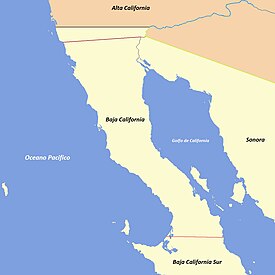
TheDominicanstook over management of the Baja California missions from the Franciscans in 1773. They established a chain of new missions among the northern Cochimí and western Yumans, first on the coast and subsequently inland, extending fromEl Rosario(1774) toDescanso(1817), just south of Tijuana below thePalóu Line.
In 1804, the Spanish crown divided California intoAlta ('Upper')andBaja ('Lower') Californiaat the line separating theFranciscanmissions in the north from theDominicanmissions in the south. The colonial governors were José Joaquín de Arillaga (1804–1805),Felipe de Goicoechea(1806–1814), andJosé Darío Argüello(1814 – April 11, 1822).
Post-independence, 1821–present[edit]
Early republic[edit]
Mexican liberalswere concerned that theRoman Catholic Churchretained too much power in the post-independence period and sought to undermine it by mandating thesecularization of missionsin 1833. In the aftermath of theMexican American War(1846–1848) and theTreaty of Guadalupe Hidalgo,the United States gained sovereignty over territory previously held first byNew Spainand then Mexico, most of which was sparsely settled. Alta California was incorporated into the U.S., and during theCalifornia Gold Rush,quickly gained enough population to be admitted to the union as a state. Baja California gains control of where is now the cities ofTijuana,Mexicali,andTecatefrom Alta California after the treaty and remained under Mexican control. In 1853, soldier of fortune (mercenary)William WalkercapturedLa Paz,declaring himself president of theRepublic of Baja California.The Mexican government forced his retreat after several months.
Era of Porfirio Díaz[edit]
When liberal army generalPorfirio Díazcame to power in 1876, he embarked on a major program to develop and modernize Mexico.
- 1884: Luis Huller andGeorge H. Sissonobtain a concession covering much of the present state in return for promises to develop the area.[15]
- 1905: TheMagonistarevolution, ananarchistmovement based on the writings ofRicardo Flores MagónandEnrique Flores Magón,begins.
- 1911: Mexicali and Tijuana are captured by theMexican Liberal Party(Partido Liberal Mexicano,PLM), but soon surrender to Federal forces.
Postrevolutionary Mexico[edit]
- 1917: On 11 December, "[a] prominent Mexican, close friend of PresidentCarranza"offered toU.S. SenatorHenry Ashurstto sell Baja California to the U.S. for "fifty million dollars gold".[16]
- 1931: Baja California is further divided into Northern and Southern territories.
- 1952: TheNorth Territory of Baja Californiabecomes the 29th state ofMexico,Baja California. The southern portion (below 28°N) remains a federally administered territory.
- 1974: TheSouth Territory of Baja Californiabecomes the 31st state, Baja California Sur.
- 1989:Ernesto Ruffo Appelof theNational Action Party(PAN) becomes the first non-Institutional Revolutionary Partygovernor of Baja California and the first opposition governor of any state since theRevolution.Baja California would acquire a reputation as a stronghold for PAN into the 2010s.[17]
Geography[edit]
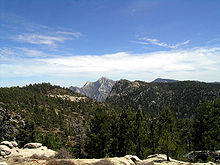
Baja California encompasses a territory withinthe Californiasregion of North America, which exhibits diverse geography for a relatively small area. ThePeninsular rangesof the California cordillera run down the geographic center of the state. The most notable ranges of these mountains are theSierra de Juárezand theSierra de San Pedro Mártir.These ranges are the location of forests reminiscent ofSouthern California'sSan Gabriel Mountains.Picacho del Diablo is the highest peak on the peninsula. Valleys between the mountain ranges are located within a climate zone that is suitable for agriculture. Such valleys include the Valle de Guadalupe and the Valle de Ojos Negros, areas that produce citrus fruits and grapes. The mineral-rich mountain range extends southwards to the Gulf of California, where the western slope becomes wider, forming the Llanos del Berrendo on the border with Baja California Sur. The mountain ranges located in the center and southern part of the state include theSierra de La Asamblea,Sierra de Calamajué, Sierra de San Luis and theSierra de San Borja.
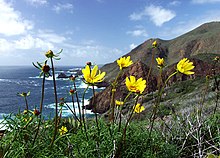
Temperate winds from the Pacific Ocean and the coldCalifornia Currentmake the climate along the northwestern coast pleasant year-round.[18]As a result of the state's location on the California Current, rains from the north barely reach the peninsula, thus leaving southern areas drier. South of theEl RosarioRiver, the state changes from a Mediterranean landscape to a desert one. This desert exhibits diversesucculentspecies that flourish in part due to thecoastal fog.
To the east, the Sonoran Desert enters the state from both California and Sonora. Some of the highest temperatures in Mexico are recorded in or nearby the Mexicali Valley.[note 2]However, with irrigation from the Colorado River, this area has become a trueagricultural center.TheCerro Prietogeothermal province is near Mexicali as well (this area is geologically part of a largepull apart basin); it produces about 80% of the electricity consumed in the state and enough additional power to export to California.Laguna Salada,a saline lake below sea level lying between the rugged Sierra de Juárez and the Sierra de los Cucapah, is also in the vicinity of Mexicali. The state government has recently been considering plans to revive Laguna Salada.[note 3]The highest mountain in the Sierra de los Cucapah is Cerro del Centinela orMount Signal.The Cucapah are the primary indigenous people from the mountains north toYuma, Arizona.
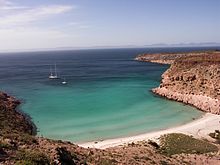
There are numerous islands on the Pacific shore. Guadalupe Island is located in the extreme west of the state's boundaries and is the site of large colonies ofsea lions.Cedros Island exists in the southwest of the state's maritime region. The Todos Santos islands and Coronado Islands are located off the coasts of Ensenada and Tijuana, respectively. All of the islands in the Gulf of California on the Baja California side belong to the municipality of Mexicali.
Baja California obtains much of its water from the Colorado River. Historically, the river drained into theColorado River Deltaand then flowed into the Gulf of California, but due to large demands for water in theAmerican Southwest,less water now reaches the Gulf. TheTijuana metropolitan areaalso relies on theTijuana Riveras a source of water. Much of rural Baja California depends predominantly on wells, a few dams and even oases. Tijuana also purchases water from San Diego County's Otay Water District. Potable water is the largest natural resource issue of the state.
Climate[edit]
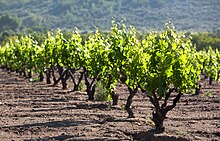
Baja California's climate varies fromMediterraneantoarid.The Mediterranean climate is found in the northwestern corner of the state, where the summers are dry and mild and the winters cool and rainy. This climate is observed in areas from Tijuana toSan Quintínand nearby interior valleys. The cold oceanic California Current often creates a low-level marine fog near the coast. The fog occurs along any part of the Pacific coast of the state.

The change of altitude towards the Sierra de Baja California creates analpine climatein this region. Summers are cool, while winters can be cold with below freezing temperatures at night. It is common to see snow in the Sierra de Juárez, Sierra de San Pedro Mártir and in the valleys in between the two ranges from December to April. Due toorographiceffects, precipitation is much higher in the mountains of northern Baja California than on the western coastal plain or eastern desert plain. Pine, cedar and fir forests are found in the mountains.
The east side of the mountains produces arain shadow,creating an extremely arid environment. The Sonoran Desert region of Baja California experiences hot summers and nearly frostless mild winters. The Mexicali Valley (which is below sea level) experiences the highest temperatures in Mexico, frequently surpassing 47 °C (116.6 °F) in mid-summer, and exceeding 50 °C (122 °F) on some occasions.
Further south along the Pacific coast, the Mediterranean climate transitions into a desert climate, but it is milder and not as hot as along the gulf coast. Transition climates, from Mediterranean to desert, can be found from San Quintín toEl Rosario.Further inland and along the Gulf of California, the vegetation is scarce and temperatures are very high during the summer months. The islands in the Gulf of California also have a desert climate. Some oases can be found in the desert where few towns are located – for instance,Catavina,San Borja and Santa Gertrudis.[which?][19]
Flora and fauna[edit]
Common trees are theJeffrey pine,sugar pineandpinon pine.[20][full citation needed]Understoryspecies includemanzanita.There is a variety of reptiles, including theWestern fence lizard,which is at the southern extent of its range.[21]The name of the fish genusBajacaliforniais derived from the Baja California peninsula.[22]
In the main wildlife refuges on the peninsula of Baja California,Constitution 1857 National ParkandSierra de San Pedro Mártir National Park,several coniferous species can be found. The most abundant are Jeffrey pine,Pinus ponderosa,Pinus cembroides,Pinus quadrifolia,Pinus monophylla,Juniperus,Arctostaphylos pringleisubsp.drupacea,Artemisia ludovicianaandAdenostoma sparsifolium.Baja California shares many plant species with theLaguna MountainsandSan Jacinto Mountainsin southwest California. The lower elevations of the Sierra de Juárez are characterized bychaparralanddesert shrub.Guadalupe Islandand its surrounding waters, 250 kilometres (160 mi) off the Pacific coast, has been designated theGuadalupe Island Biosphere Reserveto preserve endangered marine and terrestrial species of animals and plants.
The fauna in the parks include a large number of mammals, primarilymule deer,bighorn sheep,cougars,bobcats,ringtail cats,coyotes,rabbits,squirrelsand more than 30 species ofbats.The park is also home to many avian species likebald eagles,golden eagles,falcons,woodpeckers,black vultures,crows,and several species ofSittidaeandduck.
2010 earthquakes[edit]
At 3:40:41 pm PDT on Easter Sunday, 4 April 2010, a 7.2 Mw (on themoment magnitude scale) magnitude northwest-trendingstrike-slip earthquakehit theMexicali Valley,with itsepicenter26 km (16 mi) southwest of the city ofGuadalupe Victoria, Baja California.[23]The main shock was felt as far as theLos Angeles,Las Vegas,PhoenixandTucson metropolitan areas,and in Yuma.[which?]At least a half-dozenaftershockswith magnitudes between 5.0 and 5.4 were reported, including a 5.1-magnitude shaker at 4:14 am that was centered nearEl Centro.[24]As of 6:31am PDT on 5 April 2010, two people were confirmed dead.[25]
Government[edit]

Municipalities of Baja California[edit]
Baja California is subdivided into sevenmunicipios('municipalities'):Ensenada,Mexicali,Tecate,Tijuana,Rosarito,San QuintínandSan Felipe.
Politics[edit]
State elections[edit]

In Baja California, state elections are held every two years (every three years prior to 2019) for the positions ofstate governor,25 state deputies of theCongress of Baja California,and 5 municipal mayors. Of the 25 state deputies, 17 are elected by relative majority in each of the electoral districts, while another 8 are elected by proportional representation. The 17 deputies elected by relative majority may be re-elected for up to four consecutive terms, while the other 8 deputies can only serve one term.
During the 2019 Baja California state election,Jaime Bonilla Valdezof theMorena-ledJuntos Hacemos Historiacoalition won by a margin of 27.58% to become the governor of Baja California. In addition, 21 out of 25 state deputy positions and all 5 municipal mayoral positions were won by candidates aligned with the Juntos Hacemos Historia coalition.
During the 2021 Baja California state election,Marina del Pilar Ávila Olmedaof the Morena-ledJuntos Hacemos Historiacoalition won by a margin of 17.49% to become the first female governor of Baja California. Of the state's 25 local deputies, 13 were won by Morena-aligned candidates, followed in a distant second place by candidates of theSolidarity Encounter Party(PES),National Action Party(PAN), andLabor Party(PT) with 3 seats each. All 5 municipal mayoral positions were again won by Morena-aligned candidates.
The next state elections are scheduled for2023.
Federal elections[edit]
| Year | PRI | PAN | PRD | MORENA |
|---|---|---|---|---|
| 2018 | 8.86% 94,296
|
19.33% 205,747
|
63.10% 671,599
| |
| 2012 | 36.99% 446,192
|
27.20% 328,116
|
31.15% 375,803
|
|
| 2006 | 21.38% 203,233
|
47.35% 450,186
|
23.59% 224,275
|
|
| 2000 | 37.04% 319,477
|
49.76% 429,194
|
8.97% 77,340
|
|
| 1994 | 48.92% 402,332
|
36.18% 297,565
|
8.35% 68,669
|
During the2018 Mexican general election,the presidential vote of Baja California was won by a landslide of almost 44% byAndrés Manuel López Obradorof theMorenaparty. Out of the 8 federal deputies representing Baja California in theMexican Chamber of Deputies,5 were won by Morena candidates, 2 were won bySocial Encounter Partycandidates, and 1 was won by aLabor Partycandidate. The next Mexican general election is scheduled for2024.
During the2021 Mexican legislative election,six of the eight federal deputies representing Baja California in theMexican Chamber of Deputieswere won byMorenacandidates, with the other two being won by candidates of theLaborandEcologist Greenparties. The next legislative elections are scheduled for2024.
Demographics[edit]
This sectionneeds additional citations forverification.(July 2022) |
| Rank | Name | Municipality | Pop. | ||||||
|---|---|---|---|---|---|---|---|---|---|
 Tijuana  Mexicali |
1 | Tijuana | Tijuana | 1,810,645 |  Ensenada  Rosarito | ||||
| 2 | Mexicali | Mexicali | 854,186 | ||||||
| 3 | Ensenada | Ensenada | 330,652 | ||||||
| 4 | Rosarito | Playas de Rosarito | 100,660 | ||||||
| 5 | Tecate | Tecate | 81,059 | ||||||
| 6 | Villa del Campo | Tijuana | 33,360 | ||||||
| 7 | Maneadero | Ensenada | 27,969 | ||||||
| 8 | Guadalupe Victoria | Mexicali | 19,081 | ||||||
| 9 | Lázaro Cárdenas | San Quintín | 18,829 | ||||||
| 10 | San Felipe | San Felipe | 17,143 | ||||||
| Year | Pop. | ±% |
|---|---|---|
| 1895 | 42,875 | — |
| 1900 | 7,583 | −82.3% |
| 1910 | 9,760 | +28.7% |
| 1921 | 23,537 | +141.2% |
| 1930 | 48,327 | +105.3% |
| 1940 | 78,907 | +63.3% |
| 1950 | 226,965 | +187.6% |
| 1960 | 520,165 | +129.2% |
| 1970 | 870,421 | +67.3% |
| 1980 | 1,177,886 | +35.3% |
| 1990 | 1,660,855 | +41.0% |
| 1995 | 2,112,140 | +27.2% |
| 2000 | 2,487,367 | +17.8% |
| 2005 | 2,844,469 | +14.4% |
| 2010 | 3,155,070 | +10.9% |
| 2015 | 3,315,766 | +5.1% |
| 2020 | 3,769,020 | +13.7% |
| 2015 data from Encuesta Intercensal 2015.[4] | ||

Although the state is more European in ancestry, it has historically seen sizable East and Southeast Asian immigrant population. Mexicali has a large Chinese community, as well as manyFilipinoswho arrived to the state during the eras of Spanish Philippines and American rule (1898–1946) in much of the 19th and 20th centuries. Tijuana and Ensenada were major ports of entry for East Asians entering the U.S. ever since the firstAsian Americanswere present in California.[citation needed]
According to the 2020 Census, 1.71% of Baja California's population identified as Black,Afro-Mexican,or of African descent.[29]
Since 1960, large numbers of migrants from southern Mexican states have arrived to work in agriculture (especially the Mexicali Valley and nearbyImperial Valley,California, U.S.) and manufacturing. The cities of Ensenada, Tijuana, and Mexicali grew as a result of migrants, primarily those who sought U.S. citizenship. Those temporary residents awaiting their entry into the United States are calledflotillas,which is derived from the Spanish wordflota,meaning 'fleet'.[citation needed]
There is also a sizable immigrant community from Central and South America, and from the United States and Canada. An estimated 200,000+ Americanexpatriateslive in the state, especially incoastal resorttowns such as Ensenada, known for affordable homes purchased by retirees who continue to hold U.S. citizenship. San Felipe, Rosarito and Tijuana also have a large American population (second largest in Mexico after Mexico City), particularly for their cheaper housing and proximity to San Diego.[citation needed]
Some 60,000 Oaxacans live in Baja California. Some 40% of them lack proper birth certificates.[30]
According to aConsejo Nacional de Ciencia y Tecnología(Conacyt) investigator, a little under a million people were classified as "poor" in the state, up from 2008 when there were roughly 810,000. Exactly who these people are, whether locals, interstate or international migrants, was not explained.[31]
Education[edit]
Baja California offers one of the best educational programs in the country, with high rankings in schooling and achievement.
The state government provides education and qualification courses to increase the workforce standards, such as school–enterprise linkage programs which help the development of a labor force according to the needs of the industry.
91.60% of the population from six to fourteen years of age attend elementary school. 61.95% of the population over fifteen years of age attends or has already graduated from high school. Public school is available in all levels from kindergarten to university.
The state has 32 universities offering 103 professional degrees. These universities have 19 research and development centers for basic and applied investigation in advanced projects related to biotechnology, physics, oceanography, computer science, digitalgeothermaltechnology, astronomy, aerospace, electrical engineering and clean energy, among others. At this educational level, supply is steadily growing. Baja California has developed a need to be self-sufficient in matters of technological and scientific innovation and to be less dependent on foreign countries. Current businesses demand new production processes as well as technology for the incubation of companies. The number of graduate degrees offered, including PhD programs, is 121. The state has 53 graduate schools.[32]
Economy[edit]

As of 2005, Baja California's economy represents 3.3% of Mexico'sgross domestic product,or US$21.996 billion.[34][full citation needed]Baja California's economy has a strong focus on tariff-free export oriented manufacturing (maquiladora). As of 2005, 284,255 people are employed in the manufacturing sector.[34]There are more than 900 companies operating under the federalProsecprogram in Baja California.
Employment[edit]
In 2021, Baja California generated 57,550 new jobs, about 15.2 jobs per 1000 inhabitants, making it the 5th highest in the country and the second highest of any border state behindNuevo León(86,364 new jobs). The majority of these new jobs were generated in and around the cities ofTijuana,Mexicali,Ensenada,Playas de Rosarito,andTecate.Industries that experienced the highest degree of growth in 2021 includetransformative industries,transportandcommunication,commerce,andconstruction.[35]
As of November 2021, Baja California has the highestemployment rateof any state innorthern Mexico,with a rate of 96.7%.[35]
Economic investment[edit]
As of September 2021, Baja California receives the third highest amount offoreign direct investmentof any state in Mexico, constituting about 7.7% of the national total and behind onlyNuevo León(7.7%) andMexico City(16.5%). About 81.4% of Baja California's foreign domestic investment comes from theUnited States,of which 50.3% comes from the construction ofnatural gaspipelines and 8.2% comes car and truck manufacturing.[35]
Real estate[edit]
This sectionmay contain materialnot related to the topic of the article.(September 2020) |
The Foreign Investment Law of 1973[36][37]allows foreigners to purchase land within the borders and coasts of Mexico by way of a trust handled through a Mexican bank (Fideicomiso). This trust assures to the buyer all the rights and privileges of ownership, and it can be sold, inherited, leased, or transferred at any time. Since 1994, the Foreign Investment Law stipulates thatthe Fideicomiso must be to a 50-year term[clarify],with the option to petition for a 50-year renewal at any time.[38]
Any Mexican citizen buying a bank trust property has the option to either remain within the trust or opt out of it and request the title inescritura.[further explanation needed]
Mexico's early history involved foreign invasions and the loss of vast amounts of land; in fear of history being repeated, the Mexican constitution established the concept of the "Restricted Zone".[39]In 1973, in order to bring in more foreign tourist investment, the Bank Trust of Fideicomiso was created, thus allowing non-Mexicans to own land without any constitutional amendment necessary.[40]Since the law went into effect, it has undergone many modifications in order to make purchasing land in Mexico a safer investment.
Highways[edit]
- Mexican Federal Highway 1
- Mexican Federal Highway 2
- Mexican Federal Highway 3
- Mexican Federal Highway 5
- Mexican Federal Highway 12
Media[edit]
Newspapersof Baja California include[41]El Centinela,El informador de Baja California,El Mexicano (edición Tijuana),El Mexicano Segunda Edición,El Sol de Tijuana,El Vigía,Esto de las Californias,Frontera,La Crónica de Baja California,La Voz de la Frontera,andSemanario Zeta.[42][43]
See also[edit]
- History of the west coast of North America
- Las Californias
- List of Baja California cities
- Spanish missions in present-day Baja California
Notes[edit]
- ^This state is often informally referred to asBaja California Norte(literally "Lower California North" in English) orBaja Norte,to distinguish it from both theBaja California peninsulaas a whole, of which it forms the northern half, andBaja California Sur,the adjacent state that covers the southern half of the peninsula. WhileBaja NorteandBaja California Norteare well-established terms for the northern half of the Baja California peninsula, they do not officially exist as political designations for any state or region. The latter name (Baja California Norte) was officially adopted from 1974 to 1979,[10]and endured unofficially thereafter.[11]In other words, "The northern state is officially known as Baja California, but since that name is easily confused with the name for the entire peninsula, it is commonly referred to by visitors and locals alike as Baja Norte."[12]
- ^Delta in the northeast recorded 54.0 °C (129.2 °F) on 3 August 1998.
- ^The state is currently (2008) looking at a plan bySDSUAdj. Professor Newcomb (ICATS)[further explanation needed]to do this using his geothermal desalination system to supply water locally.SEMARNATbelieves this to be the first viable plan presented.[citation needed]
References[edit]
- ^ab"México en cifras".January 2016.
- ^"Transformación Política de Territorio Norte de la Baja California a Estado 29"[Political Transformation of the North Territory of Peninsula de California to the 29th State] (in Spanish). Archived fromthe originalon 14 September 2019.Retrieved20 July2008.
- ^"Medio Físico del Estado de Baja California"[Landscape of the State of Baja California].Enciclopedia de los Municipios de México(in Spanish). Archived fromthe originalon 8 March 2012.Retrieved12 February2013.
- ^ab"Encuesta Intercensal 2015"[Inter-census Survey 2015](PDF)(in Spanish).INEGI.Archived fromthe original(PDF)on 10 December 2015.Retrieved8 December2015.
- ^Citibanamex (13 June 2023)."Indicadores Regionales de Actividad Económica 2023"(PDF)(in Spanish).Retrieved13 August2023.
- ^"Daylight Saving Time Around the World 2023".timeanddate.Archivedfrom the original on 4 November 2022.
- ^"Sistema de Cuantas Nacionales de México"(PDF)(in Spanish).INEGI.2010. p. 40. Archived fromthe original(PDF)on 22 July 2011.Retrieved1 October2010.
- ^"Reporte: Jueves 3 de Junio del 2010. Cierre del peso mexicano"[Report: Thursday, 3 June 2010. Close of the Mexican peso] (in Spanish). PesoMexicano. 3 June 2010. Archived fromthe originalon 8 June 2010.Retrieved10 August2010.
- ^Saldierna, J. F.Promexico.Editorial Emán. p. 68.
- ^Lands and Peoples: North America(Volume 5 ofLands and Peoples,Grolier,2005), p. 390.
- ^"Baja California Embraces New Branding to Boost Tourism During Pandemic Recovery",Times of San Diego(23 Apr 2021).
- ^Jones, Fred and Jones, Gloria.Baja Camping: The Complete Guide,p. 6 (Avalon Travel Publishing,1994).
- ^"Rock Paintings of the Sierra de San Francisco".World Heritage List.UNESCO World HeritageConvention.Archivedfrom the original on 28 June 2015.Retrieved12 June2015.
- ^"History of Riverside County, California".Mocavo.Archived fromthe originalon 16 March 2016.
- ^de Novelo, Maria Eugenia Bonifaz (1984)."Ensenada: Its background, founding and early development".The Journal of San Diego History.30(Winter).San Diego Historical Society.Archived fromthe originalon 20 August 2008.Retrieved20 July2008.
- ^Ashurst, Henry Fountain (1962). Sparks, George F. (ed.).A Many-Colored Toga: The Diary of Henry Fountain Ashurst.Tucson, AZ:The University of Arizona Press.p. 74.
- ^Dibble, Sandra (2 July 2012)."PAN loss in Baja California mirrors Mexico's trend".San Diego Union-Tribune.Retrieved14 June2024.
Following the national trend, voters across this northwest border state — long viewed as a stronghold of the PAN — backed Enrique Peña Nieto of the Institutional Revolutionary Party in the presidential race.
- ^"Normales Climatológicas 1971–2000".Servicio Meteorológico Nacional.25 June 2007. Archived fromthe original(TXT)on 25 June 2007.
- ^Martínez-Ballesté, Andrea; Ezcurra, Exequiel (2018)."Reconstruction of past climatic events using oxygen isotopes in Washingtonia robusta growing in three anthropic oases in Baja California Sur".Boletín de la Sociedad Geológica Mexicana.70(1): 79–94.doi:10.18268/BSGM2018v70n1a5.
- ^Brandegee, Katharine Layne; Brandegee, Townshend Stith (1894)."Flora of the Cape Region".Zoe: A Biological Journal.4(4). Zoe Publishing Company – viaBiodiversity Heritage Library.
- ^Hogan, C. Michael (30 August 2008). Stromberg, Nicklas (ed.)."Western fence lizard (Sceloporus occidentalis)".Globaltwitcher.Archived from the original on 13 February 2012.
{{cite web}}:CS1 maint: unfit URL (link) - ^Townsend, Charles H.; Nichols, John T. (1925)."Deep Sea Fishes of the 'Albatross' Lower California Expedition".Bulletin of the American Museum of Natural History.52.hdl:2246/1170.
- ^"Magnitude 7.2 – Baja California, Mexico".Earthquake Hazards Program.United States Geological Survey.6 April 2010. Archived fromthe originalon 6 April 2010.Retrieved17 March2012.
- ^Associated Press(4 April 2010)."At Least Two Die In 7.3-Magnitude Baja Quake".KTVU.KTVU. Archived fromthe originalon 9 April 2010.Retrieved17 March2012.
- ^Rowlands, Ted; Valencia, Nick; Vercammen, Paul; Gilgoff, Dan (6 April 2010)."Baja governor seeks emergency declaration after quake".CNN Wire.Archivedfrom the original on 8 November 2012.Retrieved17 March2012.
- ^"Resultados de las Elecciones Federales – México 2012"[Federal Election Results – Mexico 2012] (in Spanish). Archived fromthe originalon 21 March 2013.Retrieved22 February2013.
- ^"Censo Baja California 2020".
- ^"Censo de Población y Vivienda 2010"[Census of Population and Housing 2010] (in Spanish).INEGI.2011. Archived fromthe originalon 9 March 2013.Retrieved3 February2013.
- ^"Panorama".
- ^López, Citlalli (28 November 2012)."Con problemas en acta de nacimiento 40% de oaxaqueños en Baja California"[40% of Oaxacans in Baja California have problems with birth certificates].Noticiasnet(in Spanish). Archived fromthe originalon 25 May 2014.Retrieved24 May2014.
- ^Galván, Rocío (15 October 2016)."Aumentó pobreza en BC, de 2008 al 2014"[Poverty increased in BC, from 2008 to 2014].El Sol de Tijuana(in Spanish).Organización Editorial Mexicana.Archived fromthe originalon 18 October 2016.
- ^"Education System".Invest in Baja.Mexicali, Baja California: Secretariat of Economic Development. 2014. Archived fromthe originalon 11 October 2014.
- ^Muttalib, Bashirah (21 May 2007)."Twentieth Century Fox sells Baja".Variety.Archivedfrom the original on 14 May 2018.
The studio ultimately became one of the industry's premier water-tank facilities.
- ^ab Industrial Costs in Mexico – A Guide for Foreign Investors 2007(Report). Mexico City: Bancomext. 2007. p. 86.
- ^abc"Panorama Económico de Baja California - Enero de 2022"(PDF).Secretario de Economía e Innovación de Baja California.January 2022.Archived(PDF)from the original on 6 April 2022.Retrieved6 April2022.
- ^"Foreign Investment Law"(PDF).gob.mx.Government of Mexico. 9 March 1973.Archived(PDF)from the original on 24 September 2017.Retrieved24 September2017.
- ^Vargas, Jorge A. (January 1994). "Mexico: Foreign Investment Act of 1993".International Legal Materials.33(1): 207–224.doi:10.1017/S0020782900027157.S2CID154227798.
- ^"Mexico and Direct Foreign Ownership of Coastal Property".MexiData.info.12 April 2010. Archived fromthe originalon 16 April 2010.Retrieved13 April2010.
- ^"The Restricted Zone in Mexico".Penner & Associates.Archivedfrom the original on 25 May 2014.Retrieved24 May2014.
- ^Restrepo, Mario."Buying Real Estate in Baja? You Need a Fideicomiso!".Baja Open House.Archivedfrom the original on 25 May 2014.Retrieved24 May2014.
- ^Manuel Ortiz Marín, ed. (2006).Los medios de comunicación en Baja California(in Spanish). Universidad Autónoma de Baja California.ISBN978-970-701-735-1.
- ^"Publicaciones periódicas en Baja California".Sistema de Información Cultural(in Spanish). Gobierno de Mexico.Retrieved7 March2020.
- ^"Latin American & Mexican Online News".Research Guides.San Antonio, TX:University of Texas at San Antonio Libraries.Archived fromthe originalon 7 March 2020.
Further reading[edit]
- Blaisdell, Lowell L. (1962).The Desert Revolution: Baja California, 1911.Madison, WI:University of Wisconsin Press.
- Castillo-Muñoz, Verónica (November 2016).The Other California: Land, Identity, and Politics on the Mexican Borderlands.Oakland, CA:University of California Press.ISBN9780520291638.
- Christensen, Catherine (1 May 2013). "Mujeres Públicas: American Prostitutes in Baja California, 1910–1930".Pacific Historical Review.82(2).University of California Press:215–247.doi:10.1525/phr.2013.82.2.215.
- Duncan, Robert H. (November 1994). "The Chinese and the Economic Development of Northern Baja California, 1889–1929".Hispanic American Historical Review.74(4).Duke University Press:615–647.doi:10.2307/2517494.JSTOR2517494.
- Dwyer, John J. (September 2008).The Agrarian Dispute: The Expropriation of American-Owned Rural Land in Postrevolutionary Mexico.Durham, NC:Duke University Press.ISBN978-08223-4309-7.
- Hart, John Mason (January 2006).Empire and Revolution: The Americans in Mexico since the Civil War.Berkeley, CA:University of California Press.ISBN9780520246713.
- Kerig, Dorothy Pierson (1989).Yankee Enclave: The Colorado River Land Company and Mexican Agrarian Reform in Baja California 1902–1944(PhD).University of California, Irvine.
- León-Portilla, Miguel;Piñera Ramírez, David (2010).Baja California: historia breve[Baja California: brief history] (in Spanish). Mexico City:El Colegio de México:Fideicomiso Historia de las Américas: Fondo de Cultura Económica.ISBN9786074621891.
- Martínez, Pablo L. (1956).Historia de Baja California[History of Baja California] (in Spanish). Mexico City: Editorial Baja California.
- Owen, Roger C. (1963). "Indians and Revolution: The 1911 Invasion of Baja California, Mexico".Ethnohistory.10(4).Duke University Press:373–395.doi:10.2307/480336.JSTOR480336.
- Schantz, Eric M. (February 2010). "Behind the Noir Border: Tourism, the Vice Racket, and Power Relations in Baja California's Border Zone, 1938–65". In Berger, Dina; Wood, Andrew Grant (eds.).Holiday in Mexico: Critical Reflections on Tourism and Tourist Encounters.Durham, NC:Duke University Press.pp. 130–160.ISBN978-0-8223-4571-8.
- Stern, Norton B. (1973).Baja California: Jewish Refuge and Homeland.Baja California Travels series #32. Los Angeles, CA:Dawson's Book Shop.ISBN0870932322.
- Vanderwood, Paul J. (November 2004).Juan Soldado: Rapist, Murderer, Martyr, Saint.Durham, NC:Duke University Press.ISBN978-0-8223-3415-6.
External links[edit]
 Geographic data related toBaja CaliforniaatOpenStreetMap
Geographic data related toBaja CaliforniaatOpenStreetMap- Baja California Sur: Cabo Pulmo Coral Reef in Danger
- Interamerican Association for Environmental Defense
- Enciclopedia de los Municipios de México(in Spanish)
- Baja California leads Mexico in overall crime







